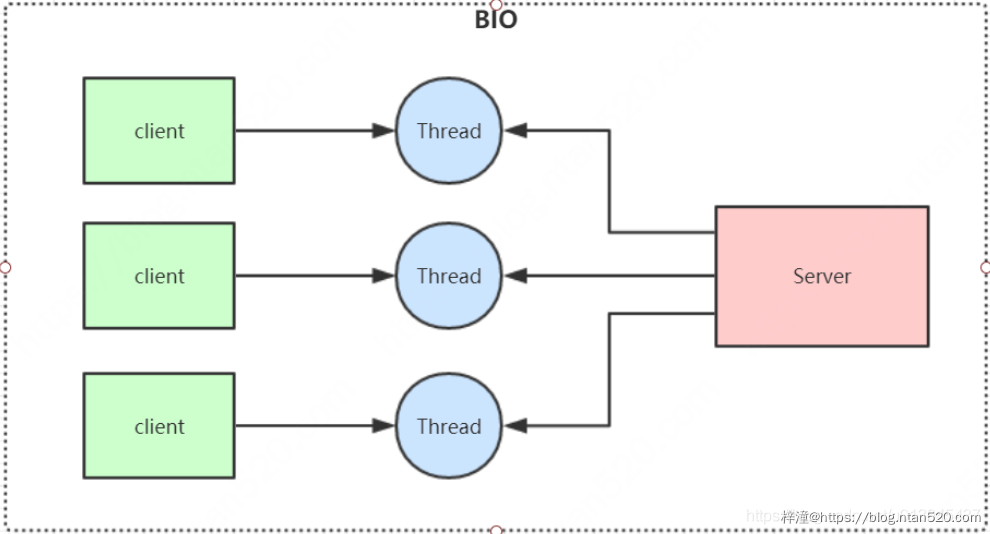文章内容
IO模型就是说用什么样的通道进行数据的发送和接收,Java共支持3种网络编程IO模式:BIO,NIO,AIO
一、BIO(Blocking IO )
同步阻塞模型,一个客户端连接对应一个处理线程

1、BIO代码示例
1)服务器代码
import java.net.ServerSocket;
import java.net.Socket;
import java.util.logging.Handler;
public class SocketServer {
public static void main(String[] args) throws Exception {
ServerSocket serverSocket = new ServerSocket(9000);
while (true){
System.out.println("等待连接");
//阻塞连接
Socket clientSocket = serverSocket.accept();
System.out.println("有客户端连接。。。");
// handle(clientSocket);
new Thread(new Runnable() {
@Override
public void run() {
try {
handle(clientSocket);
} catch (Exception e) {
e.printStackTrace();
}
}
}).start();
}
}
public static void handle(Socket clientSocket) throws Exception{
byte[] bytes = new byte[1024];
System.out.println("准备read。。");
//接收客户端的数据,阻塞方法,没有数据可读时就阻塞
int read = clientSocket.getInputStream().read(bytes);
System.out.println("read 完毕。");
if (read !=-1){
System.out.println("接收到客户端数据:" + new String(bytes,0,read));
}
clientSocket.getOutputStream().write("helloClient".getBytes());
clientSocket.getOutputStream().flush();
}
}
2)客户端代码
import java.io.IOException;
import java.net.Socket;
public class SocketClient {
public static void main(String[] args) throws IOException {
Socket socket = new Socket("localhost", 9000);
//向服务端发送数据
socket.getOutputStream().write("HelloServer".getBytes());
socket.getOutputStream().flush();
System.out.println("向服务端发送数据结束");
byte[] bytes = new byte[1024];
//接收服务端回传的数据
socket.getInputStream().read(bytes);
System.out.println("接收到服务端的数据:" + new String(bytes));
socket.close();
}
}
2、缺点
从上面的代码我们可以看出来,BIO代码中连接事件和读写数据事件都是阻塞的,所以这种模式的缺点非常的明显
- 1. 如果我们连接完成以后,不做读写数据操作会导致线程阻塞,浪费资源
- 2. 如果每来一个连接我们都需要启动一个线程处理,那么会导致服务器线程太多,压力太大,比如C10K;
3、应用场景
BIO方式适用于连接数目比较小且固定的架构,这种方式对服务器资源要求比较高,但是程序比较简单。
二、NIO(Non Blocking IO)
同步非阻塞模型,服务器实现模式为一个线程可以处理多个请求连接,客户端发送的连接请求都会注册到多路复用器(selector)上,多路复用器轮询到连接有IO请求就进行处理,JDK1.4开始引入。
1、没有引入多路复用器的代码
1)示例
import java.net.InetSocketAddress;
import java.nio.ByteBuffer;
import java.nio.channels.ServerSocketChannel;
import java.nio.channels.SocketChannel;
import java.util.ArrayList;
import java.util.Iterator;
import java.util.List;
public class NioServer {
static List<SocketChannel> channelList = new ArrayList<>();
public static void main(String[] args) throws Exception {
//创建NIO
ServerSocketChannel serverSocket = ServerSocketChannel.open();
serverSocket.socket().bind(new InetSocketAddress(9000));
//设置非阻塞
serverSocket.configureBlocking(false);
System.out.println("服务启动。。");
while (true) {
//非阻塞模式accept方法不会阻塞,否则会阻塞
//NIO的非阻塞模式是由操作系统内部实现,底层调用了Linux内核的accept函数
SocketChannel socketChannel = serverSocket.accept();
if (socketChannel != null) {
System.out.println("连接成功");
//设置socketchannel为非阻塞
socketChannel.configureBlocking(false);
//保存客户端连接到list
channelList.add(socketChannel);
}
//遍历连接读数据
Iterator<SocketChannel> iterator = channelList.iterator();
while (iterator.hasNext()) {
SocketChannel sc = iterator.next();
ByteBuffer byteBuffer = ByteBuffer.allocate(128);
//非阻塞模式read 方式不会阻塞 否则会阻塞
int len = sc.read(byteBuffer);
if (len > 0) {
System.out.println("接收到消息:" + new String(byteBuffer.array()));
} else if (len == -1) { // 如果客户端断开,把socket从集合中去掉
iterator.remove();
System.out.println("客户端断开连接");
}
}
}
}
}
2)缺点
如果连接数太多的话,会有大量的无效遍历,假如有10000个连接,其中只有1000个 连接有写数据,但是 由于其他9000个连接并没有断开看我们还是每次轮询遍历一万次,其中有 十分之一的遍历都是无效的,这显然是一个非常浪费资源的做法。
2、NIO引入多路复用器的代码
1)示例
import java.net.InetSocketAddress;
import java.nio.ByteBuffer;
import java.nio.channels.SelectionKey;
import java.nio.channels.Selector;
import java.nio.channels.ServerSocketChannel;
import java.nio.channels.SocketChannel;
import java.security.Key;
import java.util.Iterator;
import java.util.Set;
public class NioSelectorServer {
public static void main(String[] args) throws Exception {
//创建NIO ServerSocketChannle
ServerSocketChannel serverSocket = ServerSocketChannel.open();
serverSocket.bind(new InetSocketAddress(9000));
//设置ServerSocketChannel为非阻塞
serverSocket.configureBlocking(false);
//打开Selector处理channel,即创建epoll
Selector selector = Selector.open();
//把ServerSocketChannel注册selector上,并且select对客户端accept连接操作感兴趣
serverSocket.register(selector, SelectionKey.OP_ACCEPT);
System.out.println("服务启动");
//
while (true) {
//阻塞等待需要处理的事件发生
selector.select();
//获取selector中注册的全部事件的SelectionKey实例
Set<SelectionKey> selectionKeys = selector.selectedKeys();
Iterator<SelectionKey> iterator = selectionKeys.iterator();
//遍历selectionKeys对事件进行处理
while (iterator.hasNext()) {
SelectionKey key = iterator.next();
//如果是accept事件,则进行连接获取和事件注册
if (key.isAcceptable()) {
ServerSocketChannel server = (ServerSocketChannel) key.channel();
SocketChannel socketChannel = server.accept();
socketChannel.configureBlocking(false);
socketChannel.register(selector, SelectionKey.OP_READ);
System.out.println("客户端连接成功");
} else if (key.isReadable()) {
//进行数据读取
SocketChannel socketChannel = (SocketChannel) key.channel();
ByteBuffer byteBuffer = ByteBuffer.allocate(128);
int len = socketChannel.read(byteBuffer);
// 如果有数据,把数据打印出来
if (len > 0) {
System.out.println("接收到消息:" + new String(byteBuffer.array()));
} else if (len == -1) { // 如果客户端断开连接,关闭Socket
System.out.println("客户端断开连接");
socketChannel.close();
}
}
//从事件集合里删除本次处理的key,防止下次select重复处理
iterator.remove();
}
}
}
}
上面代码是利用NIO一个线程处理所有请求,这种单个线程处理的方式肯定是存在问题的,例如现在有10w个请求中,有1w个连接进行读写数据,那么SelectionKey就会有1w个请求,所以我们需要循环这1w个事件进行处理,比较费时间,如果这个时候再有连接进来,只能阻塞。
3、NIO有三大核心组件
NIO有三大核心组件:Channel(通道),Buffer(缓冲区)Selector(多路复用器)
- 1. channel 类似流,每个channel对应一个buffer缓冲区,buffer底层是个数组。
- 2. channel会注册到selector上,由selector根据channel的读写事件发生将其交由某个空闲的线程处理
- 3. NIO的Buffer和channel都是既可以读又可以写的

NIO底层在JDK1.4版本是用linux的内核函数select()或poll()来实现,跟上面的NioServer代码类似,selector每次都会轮询所有的sockchannel看下哪个channel有读写事件,有的话就处理,没有就继续遍历,JDK1.5开始引入了epoll基于事件响应机制来优化NIO。
4、示例
举个例子:例如我们去酒吧喝酒,在吧台坐下了20个人,中间一个服务员,select()或者poll()模式就是,服务员每次都是询问这个20个人是否需要喝酒,而epoll模型则是,20个人谁需要喝酒谁就举手,服务员每次只处理举手的那几个人即可。
NioSelectorServer 代码里如下几个方法非常重要,我们从Hotspot与Linux内核函数级别来理解下
Selector.open() //创建多路复用器
socketChannel.register(selector, SelectionKey.OP_READ) //将channel注册到多路复用器上
selector.select() //阻塞等待需要处理的事件发生

5、总结
NIO整个调用流程就是Java调用了操作系统的内核函数来创建Socket,获取Socket文件描述符,再创建一个Selector对象,对应操作系统的Epoll描述符,将获取到的Socket连接的文件描述符的事件绑定到Selector对应的文件描述符上,进行事件的异步通知,这样就实现了使用一条线程,并且不需要太多的无效遍历,将事件处理交给了操作系统内核(操作系统的终端程序),大大提高了效率。
6、Epoll函数详解
int epoll_create(int size);
创建一个epoll实例,并返回一个非负数作为文件描述符,用于对epoll接口的所有后续调用。参数size代表可能会容纳size个描述符,但size不是一个最大值,只是提示操作系统它的数量级,现在这个参数基本上已经弃用了。
int epoll_ctl(int epfd, int op, int fd, struct epoll_event *event);
使用文件描述符epfd引用epoll实例,对目标文件描述符fs执行op操作。参数epfd表示epoll对应的文件描述符,参数fd表示socket对应的文件描述符。
1)参数op有以下几个值
- EPOLL_CTL_ADD:注册新的fd到epfd中,并关联事件event;
- EPOLL_CTL_MOD:修改已经注册的fd的监听事件;
- EPOLL_CTL_DEL:从epfd中移除fd,并且忽略掉绑定的event,这时event可以为null;
2)参数event是一个结构体
struct epoll_event {
__uint32_t events; /* Epoll events */ epoll_data_t data; /* User data variable */ };
typedef union epoll_data {
void *ptr;
int fd;
__uint32_t u32;
__uint64_t u64;
} epoll_data_t;
3)events的可选值
events有很多可选值,这里只举例最常见的几个:
- EPOLLIN :表示对应的文件描述符是可读的;
- EPOLLOUT:表示对应的文件描述符是可写的;
- EPOLLERR:表示对应的文件描述符发生了错误;
成功则返回0,失败返回-1
int epoll_wait(int epfd, struct epoll_event *events, int maxevents, int timeout);
等待文件描述符epfd上的事件。epfd就是Epoll对应的文件描述符,events表示调用者所有可用事件的集合,maxevents表示最大等到多少个事件就返回,timeout是超时时间。
4)I/O多路复用底层
I/O多路复用底层主要用Linux内核函数(select 、poll、epoll)来实现。
| select | poll | epoll(jdk1.5及以上) | |
| 操作方式 | 遍历 | 遍历 | 回调 |
| 底层实现 | 数组 | 链表 | 哈希表 |
| O效率 | 每次调用都进行线性遍历,时间复杂度O(n) | 每次调用都进行线性遍历,时间复杂度O(n) | 事件通知方式,每当有IO事件放生,系统注册的回调函数就会被调用,事件复杂度O(1) |
| 最大连接 | 有上限 | 无上限 | 无上限 |
三、AIO模型
异步非阻塞模型,由操作系统完成后回调通知服务端程序启动线程去处理,一般适用于连接数比较多且连接时间比较长的应用
1、应用场景
AIO方式适用于连接数 多且连接比较长(重操作)的架构,JDK1.7开始支持
1)服务器代码
import java.io.IOException;
import java.net.InetSocketAddress;
import java.nio.ByteBuffer;
import java.nio.channels.AsynchronousChannel;
import java.nio.channels.AsynchronousServerSocketChannel;
import java.nio.channels.AsynchronousSocketChannel;
import java.nio.channels.CompletionHandler;
public class AIOServer {
public static void main(String[] args) throws Exception {
final AsynchronousServerSocketChannel serverChannel =
AsynchronousServerSocketChannel.open().bind(new InetSocketAddress(9000));
serverChannel.accept(null, new CompletionHandler<AsynchronousSocketChannel, Object>() {
@Override
public void completed(AsynchronousSocketChannel socketChannel, Object attachment) {
try {
System.out.println("2--" + Thread.currentThread().getName());
//再此接收客户端连接,如果不写这行代码后面的客户端连接不上服务端
serverChannel.accept(attachment,this);
System.out.print(socketChannel.getRemoteAddress());
ByteBuffer buffer = ByteBuffer.allocate(1024);
socketChannel.read(buffer, buffer, new CompletionHandler<Integer, ByteBuffer>() {
@Override
public void completed(Integer result, ByteBuffer buffer) {
System.out.println("3--"+Thread.currentThread().getName());
buffer.flip();
System.out.println(new String(buffer.array(), 0, result));
socketChannel.write(ByteBuffer.wrap("HelloClient".getBytes()));
}
@Override
public void failed(Throwable exc, ByteBuffer buffer) {
exc.printStackTrace();
}
});
} catch (IOException e) {
e.printStackTrace();
}
}
@Override
public void failed(Throwable exc, Object attachment) {
}
});
System.out.println("1--"+Thread.currentThread().getName());
Thread.sleep(Integer.MAX_VALUE);
}
}
2)客户端代码
import java.net.InetSocketAddress;
import java.nio.ByteBuffer;
import java.nio.channels.AsynchronousSocketChannel;
public class AIOClient {
public static void main(String... args) throws Exception {
AsynchronousSocketChannel socketChannel = AsynchronousSocketChannel.open();
socketChannel.connect(new InetSocketAddress("127.0.0.1", 9000)).get();
socketChannel.write(ByteBuffer.wrap("HelloServer".getBytes()));
ByteBuffer buffer = ByteBuffer.allocate(512);
Integer len = socketChannel.read(buffer).get();
if (len != -1) {
System.out.println("客户端收到信息:" + new String(buffer.array(), 0, len));
}
}
}
2、BIO、NIO、AIO对比

3、为什么Netty使用NIO而不是AIO?
因为在Linux系统上,AIO的底层实现扔使用Epoll模型,没有很好的使用AIO,因此在性能上没有明显的优势,而且被JDK封装了一层不容易再次进行深度优化,Linux上AIO还不够成熟。Netty是异步非阻塞框架,Netty在NIO上做了很多异步封装。
